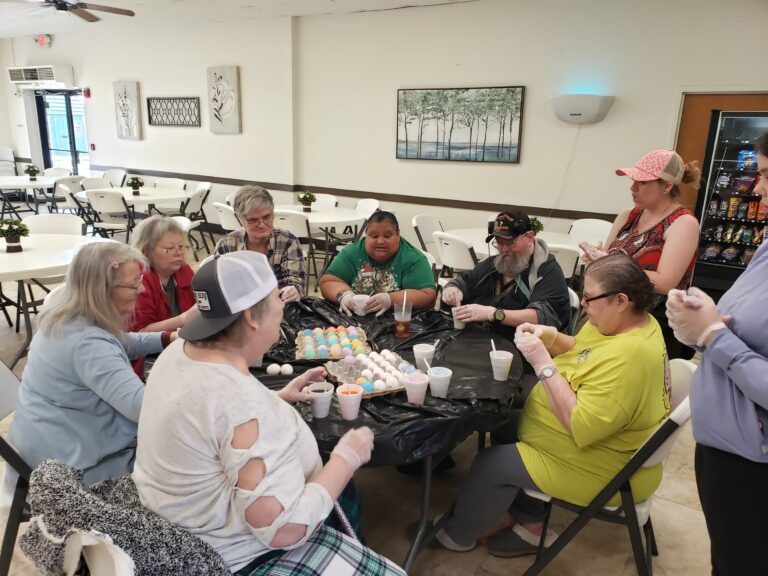Designing Accessible Housing for Individuals with Mental Illness
Creating an abode that is suited to the needs of those with mental health issues, such as designing accessible housing for individuals with mental illness, necessitates a profound comprehension of both their particular struggles and how to craft surroundings that are conducive to them. This post will delve into this complex topic, providing insights into accessibility requirements tailored to cognitive disorders.
We’ll explore strategies for designing an accessible home environment from scratch, ensuring every aspect is conducive to the well-being of residents with mental health conditions. But we’re not just focusing on new builds; adapting existing structures for improved accessibility is equally important and can be highly effective.
Furthermore, we’ll examine the role of assistive technology in creating a supportive living space for those with mental illnesses. Lastly, we’ll discuss building a community that fosters inclusivity and support – because designing accessible housing for individuals with mental illness goes beyond physical spaces; it’s about nurturing an atmosphere of understanding too.
Table of Contents:
- Understanding Mental Illness and Accessibility Requirements.
- Designing an Accessible Home Environment.
- Adapting Existing Structures for Accessibility.
- Utilizing Assistive Technology.
- Creating a Supportive Community.
- FAQs in Relation to Designing Accessible Housing for Individuals With Mental Illness.
- Conclusion.
1. Understanding Mental Illness and Accessibility Requirements
Mental illness is like a wild rollercoaster ride for the mind – it can mess with your thinking, feeling, behavior, and mood. From depression and anxiety to more complex challenges like schizophrenia or bipolar disorder, it’s a wild ride indeed.
When it comes to designing accessible housing for individuals with mental illnesses at Individual Care of Texas, we know that understanding their unique needs is key. We want to create a safe and comfy environment that caters specifically to them.
Accessibility requirements for people with mental health issues aren’t just about physical stuff. Creating a space that is secure and cozy, where those with mental health issues can feel independent and have their overall well-being taken into account, is essential.
- Safety: We gotta minimize potential harm, like removing sharp corners or making sure doors lock properly for those who may experience paranoia or fear.
- Comfort: Some environments can be stressful for individuals dealing with mental health issues. So, we use calming colors and soft lighting to create a soothing atmosphere.
- Independence: We encourage self-reliance by making it easy to navigate the house. Clear signage for different rooms, like the kitchen or bathroom, can be a big help.
- Well-being: A positive living environment is crucial for good mental health. That’s why we incorporate green spaces where residents can relax outdoors and boost their emotional well-being.
To ensure compliance with the Americans With Disabilities Act (ADA), facilities must take action to remove any barriers that can be done without great effort or expense. According to ADA guidelines, facilities must remove barriers wherever it’s “readily achievable” – meaning it’s doable without much difficulty or expense.
- Ramps should be installed where steps can’t be avoided.
- Bathrooms should have grab bars near toilets.
- All doorways must accommodate wheelchairs if necessary, and so on.
Understanding both the unique needs of individuals and the legal requirements forms the foundation of our mission at Individual Care of Texas. We’re here to provide assisted living for special needs individuals and offer them a safe haven they can truly call home.
Individual Care of Texas understands the unique needs of individuals with mental illness when designing accessible housing. They prioritize safety, comfort, independence, and overall well-being by removing potential harm, creating a soothing atmosphere, promoting self-reliance through clear signage, and incorporating green spaces for relaxation outdoors. They also adhere to legal accessibility requirements under laws like the Americans With Disabilities Act (ADA), ensuring ramps are installed where needed and bathrooms have grab bars near toilets.
Designing an Accessible Home Environment
Creating a safe and comfy home for people with mental illness means considering their unique cognitive challenges. The design should promote independence, dignity, and ease of use.
Adequate Space Planning
Step one: make sure there’s enough room for mobility aids and clear pathways between rooms. No one wants to play a real-life game of “Where’s Waldo?” just to find the bathroom.
Soothing Color Schemes
Choose calming colors like blues and greens to reduce anxiety. No need to feel like you’re living in a neon circus.
Natural Light & Ventilation
Let the sunshine in. Natural light improves mood and sleep patterns. Plus, fresh air is always a breath of fresh air.
Easily Navigable Layouts
Arrange furniture logically. No need to feel disoriented in your own residence. It’s not a maze, it’s a living space.
Incorporating Safety Features
Non-slip floors, secure locks, and fire safety equipment are a must. Safety first, folks.
Personalization
- Familiar items: Add personal touches like photos or favorite books for a cozy feel.
- Mementos: Happy memories can be a powerful tool for managing symptoms. Keep those positive vibes flowing.
Understanding individual needs is key to designing accessible homes for the mentally ill. Let’s strive to create an environment of acceptance.
3. Adapting Existing Structures for Accessibility
The process of making existing structures accessible can be as tricky as trying to solve a Rubik’s Cube blindfolded. Beneath the complexity lies a set of considerations to aid in this endeavor.
Understanding Unique Needs
First things first, you need to understand that everyone’s brain is wired differently. Mental illnesses such as depression, anxiety disorders, schizophrenia, and bipolar disorder present unique challenges for individuals. It is critical to tailor the care to each person’s particular needs. For example, someone with PTSD might need a peaceful oasis, while someone with autism might appreciate a sensory-friendly environment.
Evaluating Current Structures
Time to put on your detective hat and evaluate the existing structures. Look out for any obstacles that might hinder accessibility. Are the doorways wide enough for wheelchairs? Is the illumination sufficient for all to observe? These are the queries that require addressing.
Making Necessary Modifications
Once you’ve identified the problem areas, it’s time to roll up your sleeves and make some changes. Install ramps for those on wheels, add handrails for those who need a little extra support, and adjust the lighting to create the perfect ambiance. It’s like giving the structure a makeover but with accessibility in mind.
Ramps & Handrails:
Lighting Adjustments:
- RPI Lighting Research Center: The Impact Of Light On Outcomes In Healthcare Settings.
- Lux Review: The Science Behind Human-Centric Lighting.
But wait, there’s more. Technology can also lend a helping hand in creating accessible homes. We’ll dive deeper into this topic under our next heading, ‘Utilizing Assistive Technology’.
All these adaptations aim to create a safe and cozy home environment, which is the heart and soul of Individual Care of Texas’ mission – Assisted Living For Special Needs Individuals.
Adapting existing structures for accessibility requires understanding the unique needs of individuals with mental illness, evaluating current structures for obstacles, and making necessary modifications such as installing ramps and handrails. Lighting adjustments can also create a more comfortable environment. Utilizing assistive technology can further enhance accessibility in homes designed for special needs individuals.
4. Utilizing Assistive Technology
By leveraging the power of assistive technology, individuals with cognitive disorders can gain more independence in their daily lives. From reminder apps to smart homes, there are plenty of tools available to help individuals with cognitive disorders live more independently.
The Role of Assistive Technology
Assistive technology is like a superhero sidekick for people with mental health conditions. It can help with speaking, typing, writing, remembering, and even scheduling tasks. It’s a broad category that includes everything from simple reminder apps to fancy voice-activated smart homes.
Smart Home Technologies
In our Individual Care of Texas project at Assisted Living For Special Needs Individuals, we’re all about integrating smart home technologies. We’ve got automatic lighting systems, programmable thermostats, and even remote-controlled door locks and alarms. It’s like living in a futuristic movie but without the aliens.
Mental Health Apps & Digital Tools
We’re big fans of digital tools designed for mental health. There are apps for tracking moods, guides for meditation, and even electronic calendars to help with memory. It’s like having a personal assistant in your pocket, minus the annoying coffee runs.
Voice Activated Devices
Who needs to press buttons when you can just talk? Voice-activated devices like Amazon’s Alexa and Google Home are a game-changer. You can control your lights, adjust the temperature, and even have them remind you about important events. It’s like having a butler but without a fancy suit.
Despite the challenges of living with a mental illness, assistive technology can be an invaluable aid in improving quality of life. Assistive technology has got your back. It’s not just a convenience, it’s an essential tool for a better quality of life. At our Individual Care Texas Project, we’re dedicated to providing safe and comfortable homes for those facing unique cognitive challenges. We provide the technology to make things simpler, so you can concentrate on being your amazing self.
Assistive technology is like a superhero sidekick for individuals with mental illness, providing tools to help with speaking, typing, writing, remembering, and scheduling tasks. Smart home technologies and mental health apps offer convenience and support in daily life, while voice-activated devices like Amazon’s Alexa provide hands-free control over various functions. These assistive technologies make living with a mental illness easier and enhance the quality of life for those facing unique cognitive challenges.
Creating a Supportive Community
A supportive community is like a warm hug for those living with mental illness. It provides resources, support, and a whole lot of understanding. Let’s explore how to create a supportive atmosphere.
Fostering Understanding and Empathy
Education is key. Let’s spread awareness about different mental illnesses, their symptoms, and how we can lend a helping hand. Check out the National Alliance on Mental Illness (NAMI) for some mind-blowing information.
Specialized Training Programs
Let’s equip families and caregivers with the skills they need to support their loved ones. Practical skills and emotional coping strategies are the name of the game.
Easy Access to Mental Health Services
Professional help should be just a hop, skip, and jump away. Find mental health services like therapists and occupational therapists who can make life a little easier.
Let’s Get Social.
No one should feel alone. Let’s organize group activities like communal meals, movie nights, and art classes to bring everyone together. It’s all about inclusion and having a blast.
Suitable Housing Options
Individual Care of Texas is on a mission to create the perfect homes for those with unique cognitive challenges. They’re all about safety, comfort, and helping individuals thrive. Check them out at Individual Care Of Texas Inc.
Let’s join forces to create a safe, supportive environment for those struggling with mental health issues. Together, we can make a difference, one home at a time.
FAQs in Relation to Designing Accessible Housing for Individuals With Mental Illness
Why is it important to make buildings and services accessible to people with physical and mental challenges?
Accessibility ensures equal opportunities for everyone, including those with physical and cognitive disabilities, and promotes independence, dignity, and social inclusion.
How could you modify the home to safely and comfortably house an individual who uses a wheelchair?
Homes can be modified by installing ramps, widening doorways, lowering countertops in kitchens and bathrooms, and making other necessary modifications.
What is accessible design for people with disabilities?
Accessible design involves creating environments that are usable by all people without the need for adaptation or specialized design.
Why is accessible housing important?
Accessible housing allows individuals with disabilities to live independently while promoting their safety and comfort.
Conclusion
Designing accessible housing for individuals with mental illness is crucial in providing a safe and supportive environment. Understanding the unique needs of those with cognitive disorders, such as individuals with mental illness, allows us to create homes that promote independence and well-being. By incorporating universal design principles and utilizing assistive technology, we can ensure equal access to living spaces for individuals with mental illness. Designing a home for mentally ill individuals that fosters a supportive community provides social connections and resources for ongoing support.






